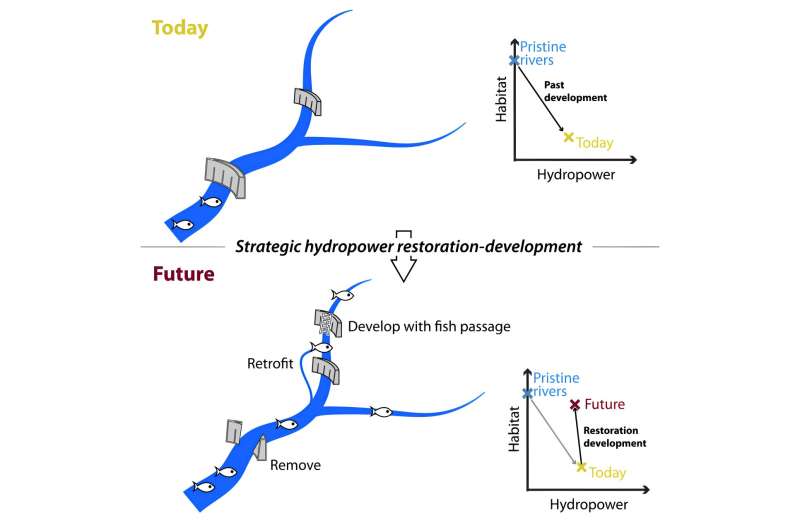This article has been reviewed according to Science X's editorial process and policies. Editors have highlighted the following attributes while ensuring the content's credibility:
fact-checked
peer-reviewed publication
trusted source
proofread
Strategic dam placement can balance hydropower and fish preservation

Hydropower plants need not be disastrous for fishermen and nature. For that, we need to place new dams more strategically, but also modify or even remove some existing ones. Valerio Barbarossa and Rafael Schmitt showed that with a computer model of the Asian Mekong basin.
A conflict between the sustainable development goals of affordable and clean energy on one hand and life below water, and no poverty and hunger on the other is starkly evident in and around the Mekong. This river originates in Tibet and flows into the South China Sea after 4,900 kilometers. Barbarossa explains, "This river basin hosts one of the most productive freshwater fisheries on Earth. It is home to more than 1,000 fish species, and this fish forms the primary income for many families."
Over the past thirty years, the fish and fisherfolks in the Mekong Basin have increasingly faced problems due to large dams for hydropower generation. "These have been placed ad hoc, without considering the consequences for fish and the livelihoods of many depending on them," says Barbarossa.
Optimal hydropower with fish preservation
Generating the same or even slightly more hydropower without all those side effects is possible. Barbarossa from the Leiden Institute of Environmental Sciences and Rafael Schmitt from Stanford University in California explored how to optimally organize hydropower generation while preserving fish populations. They published their work on June 12 in One Earth.
The two researchers created a computer model of the lower Mekong Basin, meaning that the part occupied by China is excluded. The model initially assumed a situation without dams and searched for an optimal distribution of dams across the Mekong's entire river basin.
Optimal for the model meant maximum hydropower generation and minimal impact on fish populations. Thus, the model placed dams by minimizing the cascading effects that barriers have on fish habitats. The model also retrofitted dams with, for instance, fish ladders where possible.
A bypass allows megafauna to swim past the dam
"Fish ladders are not an optimal solution for many fish," Barbossa explains. "They usually target fish like salmon with specific swimming characteristics." Other solutions, like nature-like bypasses, could further improve the longitudinal connectivity more than ladders, allowing more fish species to pass around the barrier.
"Particularly some of the basin's 'megafauna' like the Giant Mekong catfish that can reach three meters in length and weigh up to 350 kg. However, these fish passage solutions only work for relatively small dams, lower than 50 meters, so they should not be seen as a silver bullet," he emphasizes.
The researchers compared the very best scenario with one that closely resembled the current distribution of dams. They outlined three scenarios for policymakers: with low, medium, and high ambition levels.
At the lowest ambition level, all existing dams remain, only future dams are strategically positioned for optimal hydropower and fish populations. At the medium ambition level, the eight dams with the greatest impact on fish and less than fifty meters high are enhanced with fish passages. This allows some fish to partially migrate upstream or downstream again. From this starting point, the computer model proposed other new, strategic dams with fish passages.
Removing dams brings about the highest benefits
In the highest ambition scenario, ten dams are removed and replaced with dams in different locations. This brings about the highest benefits for fish and total hydropower revenues. It may seem unlikely to happen, but it is already happening in the EU and the US. Schmitt. The researchers say, "Every year, thousands of, often obsolete dams are removed. Just have a look at the website damremoval.eu."
The two scientists conducted their research with the Mekong River Commission in mind. Barbarossa explains, "All Mekong countries except China work together within this international commission to generate—preferably sustainable—hydropower for the Mekong region. If policies to protect freshwater biodiversity in such an international basin are possible, this commission could facilitate them."
More hydropower is expected
The researchers believe their model is also relevant to other parts of the world. "It has been projected that by 2050, there might be 70 % more hydropower than now," they write.
"Especially along the tropical belts, hosting high fish diversity and highly productive freshwater ecosystems, hydropower is booming. The Amazon region is a clear example of this." With Barbarossa and Schmitt's method, policymakers can use hydropower while minimizing harm to fish populations and the people who depend on them.
More information: Valerio Barbarossa et al, Strategic restoration-development mitigates tradeoffs between hydropower and fish habitat fragmentation in the Mekong, One Earth (2024). DOI: 10.1016/j.oneear.2024.05.009


















